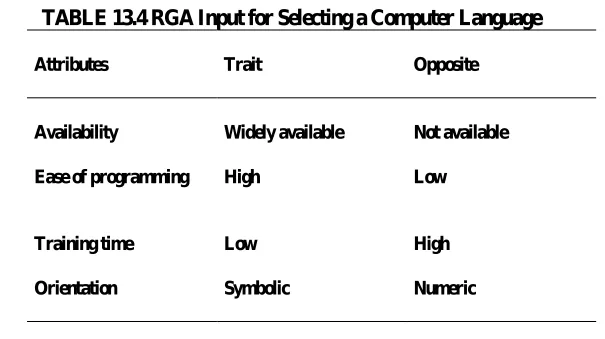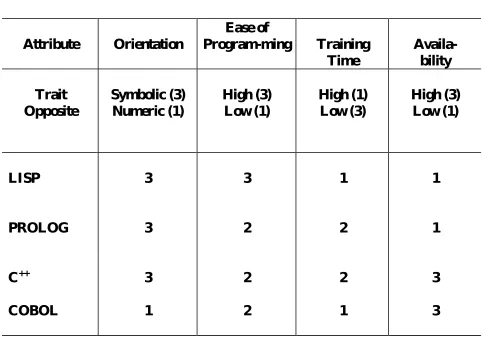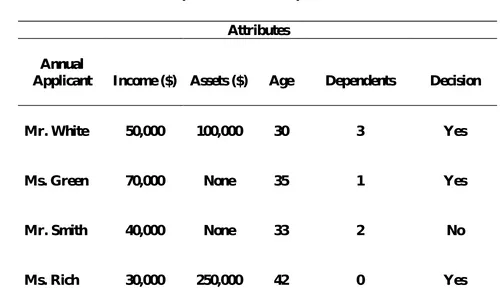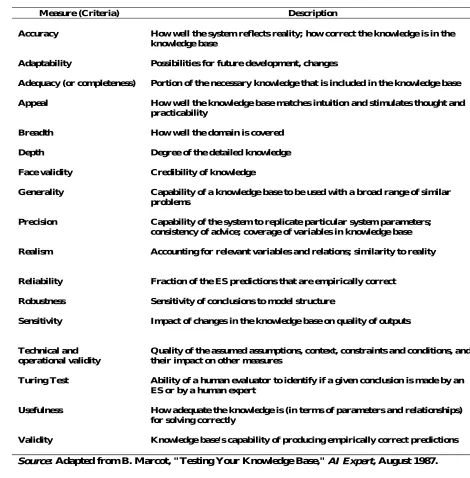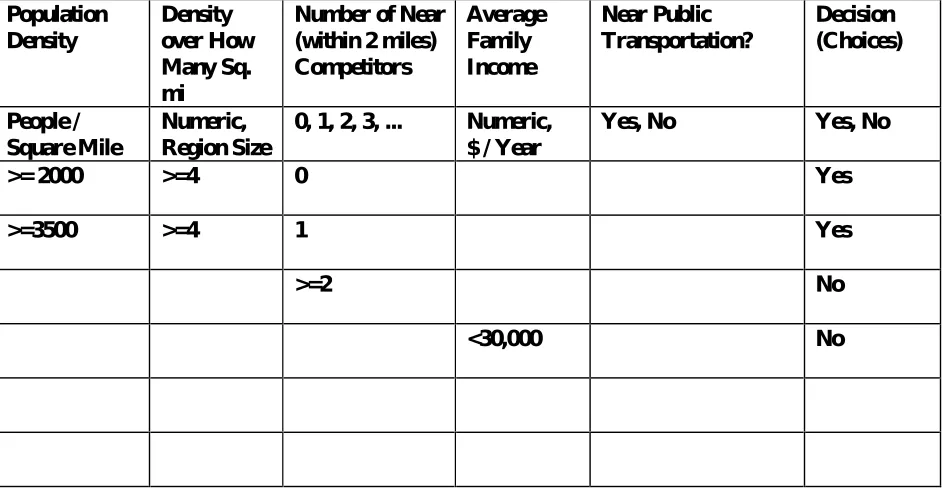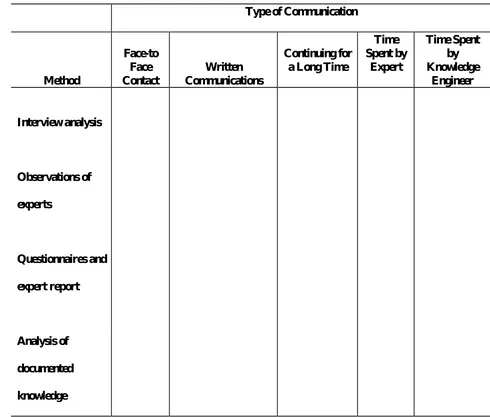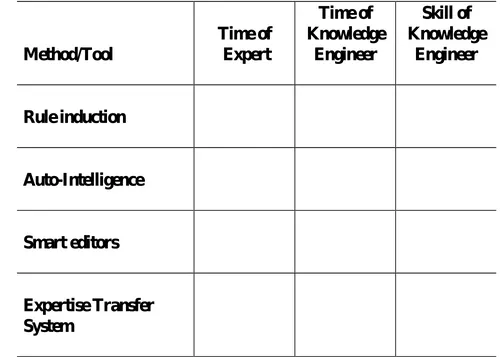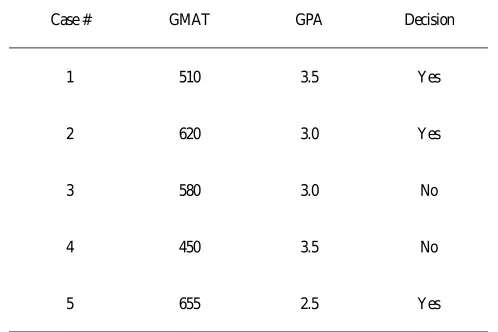Chapter 13: Knowledge
Acquisition and Validation
13.1 Opening Vignette: American Express
Improves Approval Selection
with Machine Learning
The Problem: Loan Approval
85 to 90 % Predicted Accurately
10 to 15 % in
Gray Area
Accuracy of Loan Officer’s
Gray Area
The Solution
ES with Knowledge Acquisition
Method of
Machine Learning
Rule Induction
Method
Gray Area:
Induced Decision
Tree
Correctly Predicted 70 %
Induced Rules
Explain
Why
13.2 Knowledge Engineering
The art of bringing the principles and tools of AI
research to bear on difficult applications problems
requiring experts' knowledge for their solutions
The technical issues of acquiring this knowledge,
representing it and using it appropriately to construct
and explain lines-of-reasoning are important problems
in the design of knowledge-based systems
The art of constructing intelligent agents is both part
of and an extension of the programming art
It is the art of building complex computer programs
that represent and reason with knowledge of the
world
Narrow perspective:
knowledge engineering deals
with knowledge acquisition, representation,
validation, inferencing, explanation and
maintenance
Wide perspective:
KE describes the
entire process
of developing and maintaining AI systems
We use the
Narrow Definition
–
Involves the cooperation of human experts
Knowledge
Engineering Process
Activities
Knowledge Acquisition
Knowledge Validation
Knowledge Representation
Inference
Explanation and Justification
13.3 Scope of Knowledge
Knowledge acquisition
is the extraction
of knowledge from sources of expertise
and its transfer to the knowledge base
and sometimes to the inference engine
Knowledge
is a collection of specialized
facts, procedures and judgment rules
Knowledge Sources
Documented (books, manuals,
etc.)
Undocumented (in people's minds)
–
From people, from machines
Knowledge Acquisition from
Databases
Knowledge Acquisition Via the
Knowledge Levels
Shallow
Knowledge (surface)
Deep
knowledge
Can implement a computerized representation that is
deeper
than shallow knowledge (Example: Figure 13.3)
Special knowledge representation methods (semantic
networks and frames) to allow the implementation of
deeper-level reasoning (abstraction and analogy):
important expert activity
Represent objects and processes of the domain of
expertise at this level
Major Categories of
Knowledge
Declarative Knowledge
Procedural Knowledge
Declarative Knowledge
Descriptive Representation of
Knowledge
Expressed in a factual statement
Shallow
Important in the initial stage of
Procedural Knowledge
Considers the manner in which
things work under different sets of
circumstances
–
Includes step-by-step sequences and
how-to types of instructions
–
May also include explanations
–
Involves automatic response to stimuli
–
May also tell how to use declarative
Descriptive knowledge relates to a
specific object. Includes information
about the meaning, roles, environment,
resources, activities, associations and
outcomes of the object
Procedural knowledge relates to the
Metaknowledge
Knowledge about Knowledge
In ES,
Metaknowledge
refers to
knowledge about the operation
of knowledge-based systems
13.4 Difficulties in
Knowledge Acquisition
Problems in Transferring
Knowledge
Expressing the Knowledge
Transfer to a Machine
Number of Participants
Experts may lack time or not cooperate
Testing and refining knowledge is complicated
Poorly defined methods for knowledge elicitation
System builders may collect knowledge from one source, but
the relevant knowledge may be scattered across several
sources
Collect documented knowledge rather than use experts
The knowledge collected may be incomplete
Difficult to recognize specific knowledge when mixed with
irrelevant data
Experts may change their behavior when observed and/or
interviewed
Problematic interpersonal communication between the
knowledge engineer and the expert
Overcoming the
Difficulties
Knowledge acquisition tools with ways to
decrease the representation mismatch between
the human expert and the program (“learning
by being told”)
Simplified rule syntax
Natural language processor to translate
knowledge to a specific representation
Impacted by the role of the three major
participants
–
Knowledge Engineer
–
Expert
Critical
–
The ability and personality of the knowledge
engineer
–
Must develop a positive relationship with the
expert
–
The knowledge engineer must create the right
impression
Computer-aided knowledge acquisition
tools
Extensive integration of the acquisition
Required Skills and
Characteristics of Knowledge
Engineers
Computer skills
Tolerance and ambivalence
Effective communication abilities
Broad educational background
Advanced, socially sophisticated verbal skills
Fast-learning capabilities (of different domains)
Must understanding organizations and individuals
Wide experience in knowledge engineering
Intelligence
Empathy and patience
Persistence
Logical thinking
13.5 Methods of Knowledge
Acquisition: An Overview
Manual
Semiautomatic
Manual Methods -
Structured Around
Interviews
Process
(Figure 13.4)
Interviewing
–
Structured
–
Semistructured
–
Unstructured
Tracking the Reasoning Process
Observing
Manual methods: slow, expensive and
Semiautomatic
Methods
Support Experts Directly
(Figure 13.5)
Automatic Methods
Expert’s and/or the knowledge
engineer’s roles are minimized
(or eliminated)
Knowledge Modeling
The
knowledge model
views
knowledge acquisition as the
construction of a model of
problem-solving behavior-- a model in terms
of knowledge instead of
representations
Can
reuse models
across
13.6 Interviews
Most Common Knowledge
Acquisition: Face-to-face
Interview Analysis
Types of Interviews
Unstructured Interviews
Seldom provides complete or well-organized
descriptions of cognitive processes because
–
The domains are generally complex
–
The experts usually find it very difficult to express
some more important knowledge
–
Domain experts may interpret the lack of structure
as requiring little preparation
–
Data acquired are often unrelated, exist at varying
levels of complexity, and are difficult for the
knowledge engineer to review, interpret and
integrate
–
Few knowledge engineers can conduct an efficient
The knowledge engineer slowly
learns about the problem
Then can build a representation of
the knowledge
Knowledge acquisition involves
–
Uncovering important problem attributes
Unstructured
Interviews
Most Common Variations
–
Talkthrough
–
Teachthrough
Structured Interviews
Systematic goal-oriented process
Forces an organized communication
between the knowledge engineer and the
expert
Procedural Issues in Structuring an
Interview (Table 13.1)
Interpersonal communication and
TABLE 13.1 Procedures for Structured Interviews
The knowledge engineer studies available material on the domain to identify
major demarcations of the relevant knowledge.
The knowledge engineer reviews the planned expert system capabilities. He
or she identifies targets for the questions to be asked during the knowledge
acquisition session.
The knowledge engineer formally schedules and plans (using a form) the
structured interviews. Planning includes attending to physical
arrangements, defining knowledge acquisition session goals and agendas,
and identifying or refining major areas of questioning.
The knowledge engineer may write sample questions, focusing on question
type, level and questioning techniques.
The knowledge engineer ensures that the domain expert understands the
purpose and goals of the session and encourages the expert to prepare prior
to the interview.
During the interview the knowledge engineer follows guidelines for
conducting interviews.
Interviews - Summary
Are important techniques
Must be planned carefully
Results
must
be verified and
validated
Are sometimes replaced by
tracking methods
Recommendation
Before a knowledge engineer interviews
the
expert(s)
1. Interview a less knowledgeable (minor) expert
–
Helps the knowledge engineer
•
Learn about the problem
•
Learn its significance
•
Learn about the expert(s)
•
Learn who the users will be
•
Understand the basic terminology
•
Identify readable sources
2. Next read about the problem
13.7 Tracking Methods
Techniques that attempt to
track
the reasoning process of
an expert
From cognitive psychology
Most common formal method:
Protocol Analysis
Protocol
: a record or documentation of
the expert's step-by-step information
processing and decision-making
behavior
The expert performs a real task and
verbalizes his or her thought process
(think aloud)
Summary (Table 13.2)
TABLE 13.2 Procedure of Protocol Analysis
Provide the expert with a full range of information normally associated with
a task.
Ask the expert to verbalize the task in the same manner as would be done
normally while verbalizing his or her decision process and record the
verbalization on tape.
Make statements by transcribing the verbal protocols.
Gather the statements that seem to have high information content.
Simplify and rewrite the collected statements and construct a table of
production rules out of the collected statements.
Produce a series of models by using the production rules.
TABLE 13.3 Advantages and Limitations of Protocol Analysis
Advantages
Limitations
Expert consciously considers
decision-making heuristics
Requires that the expert be aware of
why he or she makes a decision
Expert consciously considers decision
alternatives attributes, values
Requires that the expert be able to
categorize major decision alternatives
Knowledge engineer can observe and
analyze decision-making behavior
Requires that the expert be able to
verbalize the attributes and values of a
decision alternative
Knowledge engineer can record, and
later analyze with the expert, key
decision points
Requires that the expert be able to
reason about the selection of a given
alternative
Subjective view of decision making
Explanations may not track with
reasoning
13.8 Observations and
Other Manual Methods
Observations
Other Manual Methods
Case analysis
Critical incident analysis
Discussions with the users
Commentaries
Conceptual graphs and models
Brainstorming
Prototyping
Multidimensional scaling
Johnson's hierarchical clustering
13.9 Expert-driven Methods
Knowledge Engineers Typically
–
Lack Knowledge About the Domain
–
Are Expensive
–
May Have Problems Communicating
With Experts
Knowledge Acquisition May be
Slow, Expensive and Unreliable
Approaches to
Expert-Driven Systems
Manual
Computer-Aided
Manual Method:
Expert's Self-reports
Problems with Experts’ Reports and
Questionnaires
1. Requires the expert to act as knowledge
engineer
2. Reports are biased
3. Experts often describe new and untested ideas
and strategies
4. Experts lose interest rapidly
5. Experts must be proficient in flowcharting
6. Experts may forget certain knowledge
Benefits
May provide useful preliminary
knowledge discovery and
acquisition
Computer support can
Computer-aided
Approaches
To reduce or eliminate the potential
problems
–
REFINER+ - case-based system
–
TIGON - to detect and diagnose faults in a
gas turbine engine
Other
–
Visual modeling techniques
13.10 Repertory Grid
Analysis (RGA)
Techniques, derived from
psychology
Use the classification interview
Fairly structured
Primary Method:
The Grid
Based on
Kelly
's model of human thinking:
Personal Construct Theory (PCT)
Each person is a "personal scientist" seeking to
predict and control events by
–
Forming Theories
–
Testing Hypotheses
–
Analyzing Results of Experiments
Knowledge and perceptions about the world (a
domain or problem) are classified and
categorized by each individual as a personal,
perceptual model
How RGA Works
1. The expert identifies the
important objects
in
the domain of expertise (interview)
2. The expert identifies the important
attributes
3. For each attribute, the expert is asked to
establish a bipolar scale with distinguishable
characteristics (traits) and their opposites
[see
Table 13.4]
4. The interviewer picks any three of the objects
and asks: What attributes and traits
TABLE 13.4 RGA Input for Selecting a Computer Language
Attributes
Trait
Opposite
Availability
Widely available
Not available
Ease of programming
High
Low
Training time
Low
High
Step 4 continues for several
triplets of objects
Answers recorded in a
Grid
(Table 13.5)
Expert may change the ratings
inside box
Can use the grid for
TABLE 13.5 Example of a Grid
Attribute
Orientation
Ease of
Program-ming
Training
Time
Availa-bility
Trait
Opposite
Symbolic (3)
Numeric (1)
High (3)
Low (1)
High (1)
Low (3)
High (3)
Low (1)
LISP
3
3
1
1
PROLOG
3
2
2
1
C
++3
2
2
3
Use of RGA in Expert
Systems - Tools
Expertise Transfer System
(ETS)
–
(Now in AQUINAS)
AQUINAS
Other RGA Tools
PCGRID (PC-based)
WebGrid
13.11 Supporting the
Knowledge Engineer
Knowledge Acquisition Aids
Special Languages
Editors and Interfaces
Explanation Facility
Revision of the Knowledge Base
Pictorial Knowledge Acquisition
Integrated Knowledge Acquisition Aids
–
PROTÉGÉ-II
–
KSM
–
ACQUIRE
–
KADS (Knowledge Acquisition and
Documentation System)
Front-end Tools
13.12 Machine Learning: Rule
Induction, Case-based Reasoning,
Neural Computing, and Intelligent
Agents
Manual and semiautomatic elicitation methods: slow
and expensive
Other Deficiencies
–
Frequently weak correlation between verbal reports
and mental behavior
–
Sometimes experts cannot describe their decision
making process
–
System quality depends too much on the quality of the
expert and the knowledge engineer
–
The expert does not understand ES technology
Computer-aided Knowledge
Acquisition, or Automated
Knowledge Acquisition
Objectives
Increase the productivity of knowledge
engineering
Reduce the required knowledge
engineer’s skill level
Eliminate (mostly) the need for an expert
Eliminate (mostly) the need for a
knowledge engineer
Increase the quality of the acquired
Automated Knowledge
Acquisition (Machine
Learning)
Rule Induction
Case-based Reasoning
Neural Computing
Machine Learning
Knowledge Discovery and Data Mining
Include Methods for Reading
Documents and Inducing Knowledge
(Rules)
Other Knowledge Sources (Databases)
Tools
–
KATE-Induction
Automated Rule
Induction
Induction
: Process of
Reasoning from Specific to
General
In ES: Rules Generated by a
Computer Program from Cases
TABLE 13.6 Case for Induction - A Knowledge Map
(Induction Table)
Attributes
Annual
Applicant
Income ($) Assets ($)
Age
Dependents
Decision
Mr. White
50,000
100,000
30
3
Yes
Ms. Green
70,000
None
35
1
Yes
Mr. Smith
40,000
None
33
2
No
Case-based Reasoning
(CBR)
For Building ES by Accessing
Problem-solving Experiences
for Inferring Solutions for
Solving Future Problems
Cases and Resolutions
Neural Computing
Fairly Narrow Domains with Pattern
Recognition
Requires a Large Volume of Historical
Intelligent Agents for
Knowledge Acquisition
Led to
KQML (Knowledge Query and
Manipulation Language) for Knowledge
Sharing
KIF, Knowledge Interchange Format
13.13 Selecting an Appropriate
Knowledge Acquisition Method
Ideal Knowledge Acquisition System
Objectives
–
Direct interaction with the expert without a
knowledge engineer
–
Applicability to virtually unlimited problem domains
–
Tutorial capabilities
–
Ability to analyze work in progress to detect
inconsistencies and gaps in knowledge
–
Ability to incorporate multiple knowledge sources
–
A user friendly interface
13.14 Knowledge Acquisition
from Multiple Experts
Major Purposes of Using Multiple Experts
–
Better understand the knowledge domain
–
Improve knowledge base validity, consistency,
completeness, accuracy and relevancy
–
Provide better productivity
–
Identify incorrect results more easily
–
Address broader domains
–
To handle more complex problems and combine
the strengths of different reasoning approaches
Benefits And Problems With Multiple
Table 13.7 Benefits of and Problems with Participation of
Multiple Experts
Benefits
Problems
On the average, fewer mistakes by a
group of experts than by a single
expert
Groupthink phenomena
Several experts in a group eliminate
the need for using a world-class expert
(who is difficult to get and expensive)
Fear on the part of some domain
experts of senior experts or a
supervisor (lack of confidentiality)
Wider domain than a single expert's
Compromising solutions generated by
a group with conflicting opinions
Synthesis of expertise
Waste of time in group meeting
Enhanced quality from synergy
among experts
Difficulties in scheduling the experts
Handling Multiple
Expertise
Blend several lines of reasoning
through
consensus methods
Use an
analytical approach
(group
probability)
Select one of several distinct lines of
reasoning
Automate the process
Decompose the knowledge acquired
13.15 Validation and
Verification of the
Knowledge Base
Quality Control
–
Evaluation
–
Validation
Evaluation
–
Assess an expert system's overall value
–
Analyze whether the system would be usable, efficient
and cost-effective
Validation
–
Deals with the
performance
of the system (compared to
the expert's)
–
Was the “right” system built (acceptable level of
accuracy?)
Verification
–
Was the system built "right"?
Dynamic Activities
Repeated each prototype update
For the Knowledge Base
–
Must have the
right
knowledge base
–
Must be constructed properly
(verification)
Activities and Concepts In
Performing These Quality Control
TABLE 13.8 Measures of Validation
Measure (Criteria) Description
Accuracy How well the system reflects reality; how correct the knowledge is in the knowledge base
Adaptability Possibilities for future development, changes
Adequacy (or completeness) Portion of the necessary knowledge that is included in the knowledge base Appeal How well the knowledge base matches intuition and stimulates thought and
practicability
Breadth How well the domain is covered Depth Degree of the detailed knowledge Face validity Credibility of knowledge
Generality Capability of a knowledge base to be used with a broad range of similar problems
Precision Capability of the system to replicate particular system parameters; consistency of advice; coverage of variables in knowledge base Realism Accounting for relevant variables and relations; similarity to reality
Reliability Fraction of the ES predictions that are empirically correct Robustness Sensitivity of conclusions to model structure
Sensitivity Impact of changes in the knowledge base on quality of outputs
Technical and operational validity
Quality of the assumed assumptions, context, constraints and conditions, and their impact on other measures
Turing Test Ability of a human evaluator to identify if a given conclusion is made by an ES or by a human expert
Usefulness How adequate the knowledge is (in terms of parameters and relationships) for solving correctly
Method for Validating
ES
Test
1. The extent to which the system
and the expert decisions agree
2. The inputs and processes used by
an expert compared to the machine
3. The difference between expert
and novice decisions
13.16 Analyzing, Coding,
Documenting, and
Diagramming
Method of Acquisition and
Representation
1. Transcription
2. Phrase Indexing
3. Knowledge Coding
4. Documentation
Knowledge Diagramming
Graphical, hierarchical, top-down description of the
knowledge that describes facts and reasoning strategies
in ES
Types
–
Objects
–
Events
–
Performance
–
Metaknowledge
Describes the linkages and interactions among knowledge
types
Supports the analysis and planning of subsequent
acquisitions
Called conceptual graphs (CG)
13.17 Numeric and Documented
Knowledge Acquisition
Acquisition of Numeric Knowledge
–
Special approach needed to capture numeric
knowledge
Acquisition of Documented Knowledge
–
Major Advantage: No Expert
–
To Handle a Large or Complex Amount of
Information
–
New Field: New Methods That Interpret Meaning
to Determine
•
Rules
13.18 Knowledge Acquisition
and the Internet/Intranet
Hypermedia (Web) to Represent
Expertise Naturally
Natural Links can be Created in the
Knowledge
CONCORDE: Hypertext-based Knowledge
Acquisition System
The Internet/Intranet for
Knowledge Acquisition
Electronic Interviewing
Experts can Validate and Maintain Knowledge
Bases
Documented Knowledge can be accessed
The Problem: Identify relevant knowledge
(intelligent agents)
Many Web Search Engines have intelligent agents
Data Fusion Agent for multiple Web searches and
organizing
Automated Collaborative Filtering (ACF)
New Developments
WebGrid
: Web-based
Knowledge Elicitation
Approaches
Plus Information Structuring in
13.19 Induction Table
Example
Induction tables (knowledge
maps) focus the knowledge
acquisition process
Choosing a site for a hospital
TABLE 13.9: Induction Table (Knowledge Map) Example
Population Density Density over How Many Sq. miNumber of Near (within 2 miles) Competitors Average Family Income Near Public Transportation? Decision (Choices) People /
Square Mile Numeric,Region Size 0, 1, 2, 3, ... Numeric,$ / Year Yes, No Yes, No >= 2000 >=4 0 Yes >=3500 >=4 1 Yes >=2 No
Row 1: Factors
Row 2: Valid Factor Values and
Choices (last column)
Table leads to the prototype ES
Each row becomes a potential rule
Induction tables can be used to
Class Exercise: Animals
Knowledge Acquisition
Create Induction Table
–
I am thinking of an animal!
–
Question: Does it have a long neck? If yes THEN
Guess that it is a giraffe.
–
IF not a giraffe, then ask for a question to
distinguish between the two. Is it YES or NO for a
giraffe? Fill in the new Factor, Values and Rule.
–
IF no, THEN What is the animal? and fill in the new
rule.
Induction Table (Knowledge Map)
Factors Here
Decisions
Factor Values Here
Actual Choices Here Rule 1
Induction Table (Knowledge Map)
Summary
Knowledge engineering: acquisition,
representation, reasoning (inference) and
explanation
Knowledge available from many sources,
some documented, some not
Knowledge can be shallow or deep
Knowledge acquisition is difficult
Knowledge acquisition methods: manual,
semi-automated and automated
Primary manual approach is interviewing:
Experts’ reasoning process can be tracked by
several methods (protocol analysis)
Observation of experts in action is usually limited
New manual and/or computerized tools for
self-knowledge acquisition
Repertory grid analysis (RGA) is the most applied
method of semiautomated interviews
Many productivity tools for knowledge acquisition
Rule induction examines historical cases and
Rule induction can be used by a system
engineer, an expert, other system builder
Benefits, limitations and problems in several
experts
Major methods of multiple experts: consensus
methods, analytical approaches, selection of an
appropriate line of reasoning, process
automation and blackboard systems
Knowledge base validation and verification -
critical ES implementation success factors
Automated knowledge acquisition methods
are easier to validate and verify
Knowledge collected must be analyzed and
coded prior to its representation
Case-based reasoning, neural computing,
intelligent agents and other machine
learning tools can enhance the task of
knowledge acquisition
The Internet/intranet is expanding the
Questions for the
Opening Vignette
1. Why was the system’s accuracy so much better than
the human loan officers?
2. Why was an explanation facility so important here?
3. Why do you think the ES predicted much more
accurately than the Loan Officers did?
4. For the ES, what are the implications when there are
changes in the economic climate? Explain.
5. Why do you think so many test cases were needed?
6. Could the ES be used to train Loan Officers? Explain.
7. Because the rule induced decision tree is much more
accurate, comb the literature and try to estimate how
much money can be saved by denying predicted
Group Exercises
Interview a Decision Maker
1. Which interviewing technique?
2. What problems encountered?
3. What problems occurred because a group interview,
not a dialog?
4. What personality traits helped and hindered the
group, and the decision maker? Why?
5. If the decision maker actually makes a decision while
you are interviewing him/her (or shortly after), how
he/she reached the conclusion.
Tables for the Exercises
For Exercises 1, 2, 4
Table 13.10 for Exercise 1
Table 13.11 for Exercise 2
TABLE 13.10 Communication between Expert and
Knowledge Engineer
Type of Communication
Method
Face-to
Face
Contact
Communications
Written
Continuing for
a Long Time
TABLE 13.11 Comparisons of Automated Rule Induction and
Interactive Methods
Method/Tool
Time of
Expert
Time of
Knowledge
Engineer
Skill of
Knowledge
Engineer
Rule induction
Auto-Intelligence
Smart editors
TABLE 13.12 Admission Cases
Case #
GMAT
GPA
Decision
1
510
3.5
Yes
2
620
3.0
Yes
3
580
3.0
No
4
450
3.5
No
